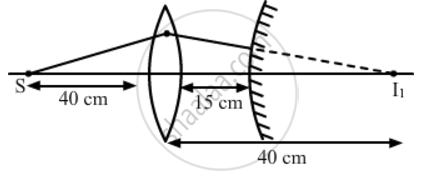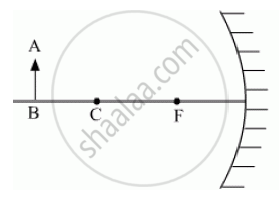Advertisements
Advertisements
प्रश्न
A convex lens of focal length 20 cm is placed coaxially with a convex mirror of radius of curvature 20 cm. The two are kept 15 cm apart. A point object is placed 40 cm in front of the convex lens. Find the position of the image formed by this combination. Draw the ray diagram showing the image formation.
उत्तर
Let us first locate the image of the point object S formed by the convex lens.
Here:
u = -40 cm
And, f = 20 cm
From the lens formula, we have:
`1/v-1/u=1/f`
`=>1/v=1/f+1/u`
`=>1/v=1/20+1/(-40)`
`=>1/v=(2-1)/40=1/40`
⇒ v = 40 cm
The positive sign shows that the image is formed to the right of the lens as shown in the following figure.

The image I1 is formed behind the mirror and hence acts as a virtual source for the mirror. The convex mirror forms the image I2, whose distance from the mirror can be calculated as:
`1/v+1/u=1/f`
Here:
u = 25 cm
And `f= R/2=10 cm`
`=>1/v=1/f-1/u`
`=>1/v=1/10-1/25`
`=>1/v=(5-2)/50=3/50`
⇒ v = 16.67 cm
Hence, the final image is formed at a distance of 16.67 cm from the convex mirror as shown in the following figure.'

APPEARS IN
संबंधित प्रश्न
An object is placed 15 cm in front of a convex lens of focal length 10 cm. Find the nature and position of the image formed. Where should a concave mirror of radius of curvature 20 cm be placed so that the final image is formed at the position of the object itself?
A mobile phone lies along the principal axis of a concave mirror. Show, with the help of a suitable diagram, the formation of its image. Explain why magnification is not uniform.
A convex lens of focal length 20 cm is placed coaxially with a concave mirror of focal length 10 cm at a distance of 50 cm apart from each other. A beam of light coming parallel to the principal axis is incident on the convex lens. Find the position of the final image formed by this combination. Draw the ray diagram showing the formation of the image
Draw a ray diagram to show image formation when the concave mirror produces a real, inverted and magnified image of the object.
A convex lens of focal length 25 cm is placed coaxially in contact with a concave lens of focal length 20 cm. Determine the power of the combination. Will the system be converging or diverging in nature?
An object AB is kept in front of a concave mirror as shown in the figure.

(i) Complete the ray diagram showing the image formation of the object.
(ii) How will the position and intensity of the image be affected if the lower half of the mirror’s reflecting surface is painted black?
Find the diameter of the image of the moon formed by a spherical concave mirror of focal length 7.6 m. The diameter of the moon is 3450 km and the distance between the earth and the moon is 3.8 × 105 km.
The convex surface of a thin concavo-convex lens of glass of refractive index 1.5 has a radius of curvature 20 cm. The concave surface has a radius of curvature 60 cm. The convex side is silvered and placed on a horizontal surface as shown in figure. (a) Where should a pin be placed on the axis so that its image is formed at the same place? (b) If the concave part is filled with water (μ = 4/3), find the distance through which the pin should be moved so that the image of the pin again coincides with the pin.

A small block of mass m and a concave mirror of radius R fitted with a stand lie on a smooth horizontal table with a separation d between them. The mirror together with its stand has a mass m. The block is pushed at t = 0 towards the mirror so that it starts moving towards the mirror at a constant speed V and collides with it. The collision is perfectly elastic. Find the velocity of the image (a) at a time t < d/V, (b) at a time t > d/V.
In the case of a concave mirror of focal length f , when an object is kept between f and 2 f , show that its image is formed beyond 2 f .
